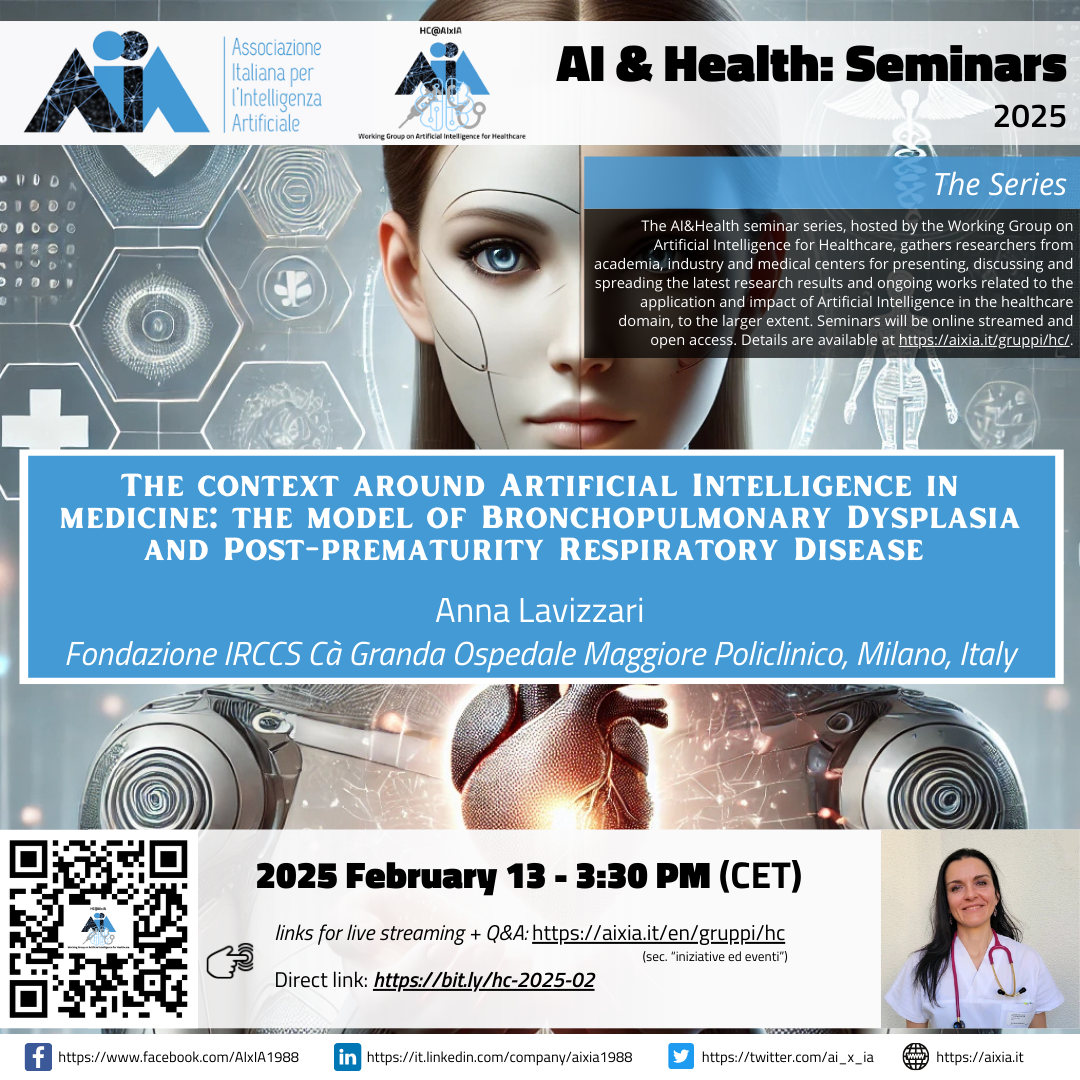- From: Francesco Calimeri <francesco.calimeri@unical.it>
- Date: Tue, 4 Feb 2025 18:54:23 +0100
- To: francesco.calimeri@unical.it
- Cc: hc-aixia <hc-aixia@googlegroups.com>, hc-aixia-members@googlegroups.com
- Message-ID: <CAB4i8BG-_AfZX+g2O+NqfFKW=EhdY5KfFJJNjtiRMwVV00uZCA@mail.gmail.com>
[*apologize for multiple postings*] Dear Madam/Sir, This is to officially announce the SECOND seminar of the "*AI & Health: Seminars 2025*" series as hosted by HC@AIxIA, i.e., the "Artificial Intelligence for Healthcare" working group of the Italian Association for Artificial Intelligence. * *** Save the date: 13 FEBRUARY 2025. 3:30 CET **** We hope you will attend and participate in the discussion on the relevant topics that will be presented and by our speakers. *Feel free to share this with those potentially interested.* *Link for participating: https://bit.ly/hc-2025-02 <https://bit.ly/hc-2025-02> *(PLEASE CHECK the site https://aixia.it/en/gruppi/hc/ for any changes or updates) - Please find some details below, and a poster attached. *== February 2025 seminar ==**2025 February 13 - 3:30PM CET* *Anna Lavizzari, MD, MSc, *Attending Physician - S.C. di Neonatologia e Terapia Intensiva Neonatale, Fondazione IRCCS Cà Granda Ospedale Maggiore Policlinico, Milano, Italy *Title*: The context around artificial intelligence in medicine: the model of Bronchopulmonary Dysplasia and Post-prematurity Respiratory Disease *Abstract*: Preterm infant survival has dramatically increased in the last decades, including those infants born at very low gestational age/at the limit of viability. However, the rate of Bronchopulmonary dysplasia (BPD) has increased. BPD is one of the most worrisome complications of prematurity and the most common chronic respiratory disorder of early childhood. Infants with BPD present respiratory sequelae in early childhood, including wheezing, recurrent respiratory infections, re-hospitalization, need for home- oxygen and inhaled therapy. During adolescence, they still present with airway obstruction symptoms, exercise fatigue, and an early decline in lung function toward Chronic Obstructive Respiratory disease has been described in early adulthood. The BPD pathogenesis is complex and multifactorial. It includes 1) the premature arrest of lung development, 2) the antenatal exposure to infection/inflammation, growth restriction and smocking; 3) post-natal exposure to invasive/non-invasive respiratory support and supplemental oxygen, post-natal infections/inflammation and poor nutrition; 4) genetic predisposition. The formal diagnosis of BPD is assessed at 36 weeks post-menstrual age, and it is currently based on the degree of respiratory support required at that time point. However, the window for intervention (preventive strategies and pharmacological interventions) occurs in the first days of life. Diagnostic tools for early identification of infants at risk are currently lacking, due to both the vulnerability of this population and the lack of suitable lung function testing. Artificial intelligence has the potential for early identification and stratification of the population at risk, offering the opportunity for targeted therapy and more accurate prognostic prediction. *Short Bio*: Anna Lavizzari is a consultant neonatologist at the Neonatal Intensive Care Unit of Fondazione IRCCS Cà Granda Ospedale Maggiore Policlinico – Milan, Italy. Her clinical research has focused on lung recruitment strategies at birth, neonatal non-invasive respiratory support, Forced Oscillation Technique for assessing respiratory mechanics, individualized surfactant therapy, respiratory support optimization and lung function follow-up of former preterm infants. She did a research fellowship at the Murdoch Children’s Research Institute, Melbourne (2013-2014) with Dr D Tingay and Dr P Dargaville. She has participated in experimental research on the long-term respiratory complications in former preterm lambs (Dr J Pillow, University of Western Australia, and Dr K Albertine, University of Utah). She served as secretary (2019-2021) and chair (2022-2024) of the Pediatric and Neonatal Intensive Care group of the European Respiratory Society. She is a member of the Pulmonology Board of the Italian Society of Neonatology (SIN) and a member of the Pulmonology section of the European Society for Paediatric Research (ESPR). *Flyer*: https://drive.google.com/open?id=1-S7_FHkpFtm1mdBZK9fZpY9WBiFJ3htm&usp=drive_fs *Link to participate*: https://bit.ly/hc-2025-02 (PLEASE CHECK the site https://aixia.it/en/gruppi/hc/ for any changes or updates) ==== Some notes Serving as coordinators of the working group on AI for Healthcare of the Italian Association of Artificial Intelligence (AIxIA, see: https://aixia.it/en/gruppi/hc/), part of our commitment consists of fostering contamination and collaboration between AI researchers and experts and operators in Medicine and Healthcare; in particular, we aim to contribute in building a two-way road for informing healthcare operators about AI results and opportunities, while also raising awareness among AI researchers about challenges and problems in medicine and healthcare. Therefore, the 2025 seminar series, in the trail of the 2024 edition, will feature a number of experts presenting research results, projects, best practices, ideas, and more to a mixed audience of AI researchers and healthcare operators. == Are you interested in Joining the group? == Please head to https://aixia.it/en/gruppi/hc/ fo find out how. Do not hesitate to contact us at hc-aixia@googlegroups.com for any information or clarification. Thank you for your interest in the AI & Health seminar series and the HC@AIxIA working group, and see you soon! Sincerely, Francesco Calimeri, Mauro Dragoni, Fabio Stella (coordinators of the HC@AIxIA working group) [image: HC@AIxIA - Seminars AI & Health 2025 - Locandina 02 febbraio.png]
Attachments
- image/png attachment: HC_AIxIA_-_Seminars_AI___Health_2025_-_Locandina_02_febbraio.png

Received on Tuesday, 4 February 2025 17:54:50 UTC